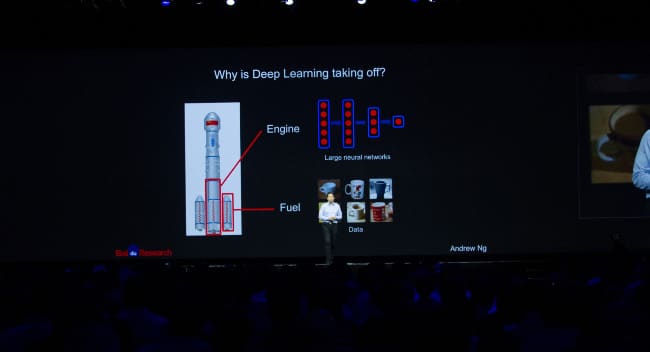Andrew Ng doesn’t think robots will kill us. But they might take our jobs.
“Maybe in hundreds of years, technology will advance to a point where there could be a chance of evil killer robots,” said Ng, a leading machine learning researcher and chief scientist at Baidu, in his keynote speech at the GPU Technology Conference Thursday.
“But I don’t work on preventing artificial intelligence from going evil for the same reason I don’t work on solving the problem of overpopulation on the planet Mars,” he said.
Recent breakthroughs have given machines uncanny new abilities, ones that will have a huge impact in the near future.
But they’ve also raised concerns. Thinkers ranging from physicist Stephen Hawking to Microsoft co-founder Bill Gates and Tesla Motors CEO Elon Musk have warned that the emergence of machine intelligence poses a threat to humanity.
Ng, who was named by Time magazine as one of the world’s 100 most influential people, doesn’t see his work posing a threat anytime soon.
“Rather than being distracted by evil killer robots, the challenge to labor caused by these machines is a conversation that academia and industry and government should have,” he said.
Ng compared the explosion in machine learning—driven by vast pools of data and powerful GPUs—to a rocket.
Faster computers—powered by GPUs—provide the rocket engine. Vast sums of data provide the fuel.
Pumping that fuel through ever more powerful engines results in rocket that can take researchers farther, faster.

The result is machines that are already able to perform tasks better than humans, like identifying scenes in photographs.
“We think that Baidu and other organizations are well beyond what humans are able to achieve on tasks that humans are really good at,” Ng said.
Ng is leading Silicon Valley research efforts at Baidu and continues to teach computer science at Stanford University. Prior to Baidu, he led the Google Brain project.
He’s among a handful of researchers who have used GPUs to spark a renaissance in deep learning that has given computers the ability to do things—like recognize images and translate speech—that seemed impossible just a few years ago.
While deep learning is complicated stuff, Ng provided a simple explanation for how it works—and why so many breakthroughs have happened in the past few years.
One factor: ubiquitous electronic devices are generating vast pools of user generated data—images, speech, video—that can be crunched by researchers.
The other factor: More sophisticated deep learning networks, supported by ever more powerful processors. These networks are very loosely modeled on the human brain—which Ng pointed out that we know very little about—and are arranged into layers that categorize the information streamed through them by researchers.
GPUs play a key role here by helping researchers feed this data to their models more quickly, giving them the ability to try out new network architectures faster, and build systems that can sort everything from speed to video quickly.
Researchers are still trying to understand how this technology can be applied. But Ng sees deep learning sparking breakthroughs in a wide range of industries, from medical imaging to transportation.
“I hope you will have grandchildren who will come to you and ask ‘Is it really true that when you were young and you came home and said something to your microwave that it just would sit there?’”
Meanwhile, smarter machines can help us with challenges people face in the present. Ng compared mastery of machine learning to a super power, a power that’s already helping people like Li Chongyang, a blind man who uses speech recognition to listen to music and place phone calls on his smart phone.
“You have superpowers,” Ng told his GTC audience. “I hope you all go home and use your superpowers to create the greatest possible good for humanity.”
The post Riding the AI Rocket: Robots Won’t Kill Us, Says Top Artificial Intelligence Researcher appeared first on The Official NVIDIA Blog.